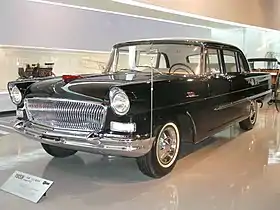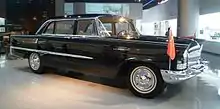Hongqi CA72
The Hongqi CA72 is a car produced by FAW Hongqi. It was the company's first production automobile and the first representative sedan that was constructed and built in China. Produced from 1958 to 1965, the CA72 was only available to state institutions and the leadership of the Communist Party of China and was regularly used in public events until the 1970s. Numerous details about technology and production are unclear.
| Hongqi CA72 | |
|---|---|
 | |
| Overview | |
| Manufacturer | Hongqi |
| Production | 1958–1965 |
| Body and chassis | |
| Class | Luxury car Full-size (F) Convertible |
| Layout | FR layout |
| Powertrain | |
| Engine | Chrysler LA engine 340 cu.in. (5.6L) V8 |
| Transmission | 2-4 speed automatic |
| Dimensions | |
| Wheelbase | 3,400 mm (133.9 in) |
| Length | 5,730–5,740 mm (225.6–226.0 in) |
| Width | 2,000–2,010 mm (78.7–79.1 in) |
| Height | 1,670 mm (65.7 in) |
| Curb weight | 2,000–2,800 kg (4,409–6,173 lb) |
| Chronology | |
| Successor | Hongqi CA770 |
History
The Hongqi CA72 was developed by First Automotive Works (FAW) based in Changchun, which was founded in 1953 with technical and financial support from the Soviet Union. First and foremost, FAW primarily produced commercial vehicles, in particular heavy trucks based on the Soviet model. In 1958, the Great Leap Forward began in China, aimed at eliminating China's industrial gap to the western industrialized countries. The effects of this initiative were also felt in the automotive sector.[1] From 1958, several Chinese plants began constructing passenger cars for civilian use. One of the first cars was the FAW-developed middle-class sedan Dongfeng CA71, which was basically a replica of the French Simca Vedette. During this time, FAW also began to develop representative vehicles for the top politicians. The initiative for this was said to have come from the party leader Mao Zedong himself, who had expressed the wish in 1955, at the CPC congress, to replace Soviet limousines[2] driving in with a car from national production.[3][4]
In August 1958, the first prototype of a saloon was completed. FAW gave the car the model name Hongqi, referring to the revolutionary symbol of the Red Flag.
The first prototype in the dimensions and in the basic technical structures already corresponded to the later production model. In the body area, however, there were significant differences. The prototype had a wide chrome strip on the sides of the car. Above the rear wheels was a large air intake, the edge of which was also chrome plated. The fan-shaped grille was very narrow at the bottom and opened far up.[5] These elements accounted for the production version. In automotive literature, the prototype is described as unattractive and coarse.[6] In the following six months, six other prototypes were created, including two four-door convertibles, all of which differed in details from each other and from the later production version.[1]



In 1959, FAW finally began mass production of the now called Hongqi CA72 sedan, which lasted until 1965 or 1967 depending on the source. Until 1962, the CA72 competed with the Beijing Automobile Works produced sedan Beijing CB4, which looked more modern, but ultimately could not prevail. Unlike the CB4, the Hongqi CA72 has been technically improved over the years in details. This affected, among other things, the brakes, which were too weak in the first vehicles. From 1965, the Hongqi was referred to as CA770. Externally and technically, the CA770 was largely identical to the CA72.
References
- Maurice A. Kelly: Russian Motor Vehicles: Soviet Limousines 1930-2003, Veloce Publishing Ltd, 2011, ISBN 9781845843007, S. 85.
- Maurice A. Kelly: Russian Motor Vehicles: Soviet Limousines 1930-2003, Veloce Publishing Ltd, 2011, ISBN 9781845843007, S. 75.
- Beitrag zum Hongqi CA72 auf der Internetseite der Botschaft der VR China in Deutschland vom 19. September 2013 (abgerufen am 6. Juni 2016).
- Weijing Zhu (2013-07-21). "The Red Banner of China's Auto Industry Rises Again". www.theworldofchinese.com. Retrieved 2016-06-06.
- Abbildung des Prototyps von 1958 at the Wayback Machine (archived June 6, 2016) (abgerufen am 6. Juni 2016).
- Maurice A. Kelly: Russian Motor Vehicles: Soviet Limousines 1930-2003, Veloce Publishing Ltd, 2011, ISBN 9781845843007, S. 76.